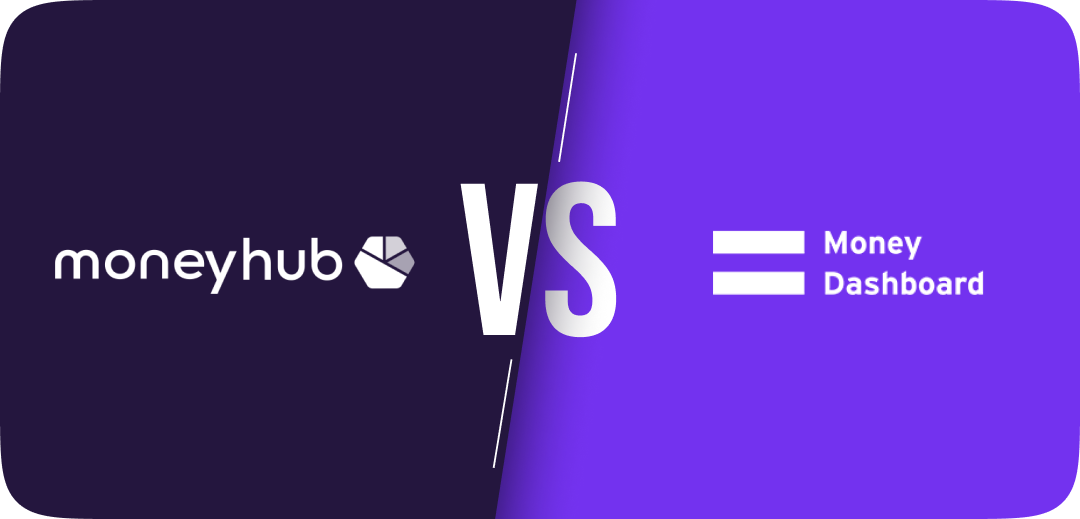FEATURED ARTICLE
Moneyhub vs Money Dashboard- Which is best?

Ainsley Bilton
July 4, 2023 •6 min read
TABLE OF CONTENTS
Budgeting & Analytics
Savings
Integration & Compatability
Comparison Table
Personal finance apps are an incredible tool to help you manage your money in a more efficient and straightforward way. With the ability to provide comprehensive insights, these apps automate tasks that are typically seen as stressful and overwhelming.
In our quest to help you find the app that is right for you, we are comparing the apps Moneyhub with Money Dashboard. Both apps offer a comprehensive way to manage your personal finances but the two have several different features and benefits so this blog post will break them down to help you find the right app for you!
Personal finance is just that-personal, so it is important to find tools that work for you! Every person’s situation and financial goals are different and in order to best meet them you need to manage your finances in a way that works for you.
Before we break down the specific offerings of each personal finance app it is important to note that Moneyhub offers 6 months free but requires a paid subscription after that while Money Dashboard is completely free.
The fees reflect Moneyhub's decision to never sell your data to third-company parties where Money Dashboard does sell data.
Budgeting & Analytics
Moneyhub brings all of your financial information together so you can see where you are spending and on what, therefore helping you to budget better to save more.
With Moneyhub users can
- Gain insights on their spending habits
- Set custom budgets
- Compare past months spend to current spending
- Gain Insights on spending, income and investments
Moneyhub supports connections with bank accounts, credit cards, savings accounts, mortgages, pensions, and investments so you can have a full picture of your finances and adjust your spending behaviours accordingly.
Once you set a realistic budget, Moneyhub will send you nudges to tell you how far through you are for each budget, so you can adjust your spending throughout the month and stay on track with your financial goals.
The focus of the app is primarily on providing insights to help you save and one way they do this is with the custom-created spending analysis. Consumers can change their insights to what resonates best with them whether that be a bar graph comparing previous months to the current, or a pie chart breaking down your spending for this budgeting period.
Moneyhub also allows you to see a category-by-category breakdown of your spending during the monthly period and how it compares to previous months.
With Moneyhub you can set a custom budget based on your financial goals. Moneyhub allows you to line up your budget with your day and tracks spending from there. Unlike Emma which allows you to choose the timeframe for your budget, Moneyhub only offers a budget centered on your payday so if you have an irregular pay schedule this may not be the best app for you.
Moneyhub also offers an income analysis and investment analysis within their insights so you can track not only where your money is going but also where it is coming from and how it is working for you, by connecting either a pension or investment account.
One other feature of Moneyhub’s analytics is their regular payments insights which show upcoming expected payments like your rent or subscriptions.
Now let's take a look at Money Dashboard. The app works similarly by utilizing open banking technology to compile your financial accounts into one place.
Creating comprehensive insights and budgeting tools is also a major focus of Money Dashboard. Unlike Moneyhub, all of Money Dashboard’s features are available at no additional cost to users.
With Money Dashboard users can:
- Track spending categorically
- Set a custom budget in the app
- View the trends of your income, spending, and saving each month
- View spending by merchant or category
Money Dashboard offers the ability to see your spending habits as trends over time whether that be from one account or multiple connected in the app.
Users can further distinguish between all categories or specific categories, as well as, set the period for which they want to view the trends from the last week, two weeks, pay cycle, month, year, or custom dates. You can further decide what time frame you want to compare this data against whether that be compared to other pay cycles, months, weeks, or years.
Like Moneyhub, Money Dashboard also compiles your recurring charges from subscriptions into one place so you can keep track of these and hopefully eliminate any that you no longer use.
Additionally, Money Dashboard can create a custom spending plan for you based on your balance, scheduled spend, and budget. This plan has the ability to inform consumers when they are going over budget or coming in under budget and therefore will be left with more money saved this budgeting cycle.
This feature that shows your balance after bills is very similar to Emma’s true balance technology which helps users to know their true spending power. For user’s convenience you can choose the pay cycle that works best for you whether that means starting from the first day of the month, the last working day, or having your budget reset on a weekly, bi-weekly, or every 4-week cycle.
For those who like seeing their spending broken down by each transaction, Money Dashboard allows you to export a CSV of your transactions compiled across your accounts for your desired period. Whether that be the transactions from one week, one month, the whole year or a custom duration Money Dashboard can create this report to be exported.
You can even see the transactions from each category if you want them broken down further. For any transactions that may have been mislabelled or miscategorised, you can even rename the transaction to ensure it ends up in the right category.
Savings
The goal of both Moneyhub and Money Dashboard is to be able to help people save money by cutting back on their spending after seeing a detailed overview of their expenditures categorically.
By compiling the data from past months and creating analytics on spending habits from one month to the next, as well as, the ability to set and monitor a budget and recurring charges, Money Dashboard aims to help you save money.
This is different from some other competitors we have looked at that offer the ability to save within the app itself. Neither Moneyhub nor Money Dashboard offers savings features like Savings pots which are a great way to manage your money and meet your financial goals.
Competitors like Emma offer the ability to open savings pots right in the app with high-interest rates so you can grow your money while working towards your financial goals! This is one major difference between these two apps and others in the space as they focus solely on providing insights and not so much on utility.
Integration & Compatability
Another important aspect to consider when choosing a personal finance app that is right for you is ensuring it is compatible with your bank and credit cards. Both Moneyhub and Money Dashboard connect to major banks and credit cards in the UK. Moneyhub has 26 integrations in their app, which is less than their competitors Chip & Plum. Money Dashboard offers 54 connections in the app so it offers way more than Moneyhub.
Overall, both Moneyhub and Money Dashboard are great financial tools to help take control of your finances. How these apps do so are very similar with a few notable differences. Although both can get the job done their interfaces are outdated in comparison to other apps like Emma which put more of a focus on making your finances as straightforward, quick and enjoyable as possible.
Depending on your goals and what you are looking to get out of your personal finance app, Moneyhub and Money Dashboard offer great tools.
For those looking to aggregate their accounts into one place and see custom financial analysis, Moneyhub may be the app for them. For those looking to gain comprehensive insights into their spending, the Money Dashboard is a great option.
For those looking for a personal finance app that allows them to both manage the day-to-day and plan for the future, Emma offers both budgeting and spending tools as well as the ability to save and invest in the platform. When choosing a financial app it is important to evaluate what app works best for your financial goals and decide accordingly.
Comparison Table
For quick comparison we took the free and paid plans
| Moneyhub | Money Dashboard | |
| fees | £14.99 yearly or £1.49 monthly | Free |
| Savings tools | -Connect your accounts in one place -manage subscriptions | -connect your accounts in one place-manage subscriptions |
| Analytics | -Custom insights for your spending, income and investments-categorically breakdown your spend - | -balance warning notifications -review how your spending habits have changed -balance after bills |
| Budgeting Tools | -nudges to help you stay on track with your budget-create custom budget that resets each payday -creates spending plan for you to reach your goals | -split transactions for accurate tracking-creates a custom spending plan for you-create custom categories |
| Compatibility | 26 bank connections -add offline accounts manually | 54 bank connections-add offline accounts manually |
| Additional | Make bank transfers within the app | Make bank transfers within the app |
* All facts and figures are accurate at the time of writing July 4th, 2023.
References:
You may also like
Check out these related blog posts for more tips
© 2025 Emma Technologies Ltd. All Rights Reserved.
Emma is registered and incorporated in England and Wales.
Emma Technologies Ltd is an appointed representative of RiskSave Technologies Ltd, which is authorised and regulated by the Financial Conduct Authority (FRN 775330).
Payment services (Non MIFID or Deposit related products) for Emma Technologies Ltd are provided by The Currency Cloud Limited. Registered in England No. 06323311. Registered Office: Stewardship Building 1st Floor, 12 Steward Street London E1 6FQ. The Currency Cloud Limited is authorised by the Financial Conduct Authority under the Electronic Money Regulations 2011 for the issuing of electronic money (FRN: 900199). For more detail on how your money is protected please see here. You can also find Currency Cloud's Terms of Use here.
Emma Technologies is an Introducer Appointed Representative of Quint Group Limited and not a lender. Quint Group Limited is authorised and regulated by the Financial Conduct Authority (Firm Reference Number 669450). Monevo Limited is an Appointed Representative of TransUnion International UK Limited. TransUnion is authorised and regulated by the Financial Conduct Authority (Firm Reference Number 737740). Emma Technologies introduces customers first to Quint Group Limited, as a licensed credit broker, who then refers on to Monevo Limited.
Emma is registered with the Financial Conduct Authority under the Payment Services Regulations 2017 for the provision of payment services.
Financial Conduct Authority Reg Nr: 794952.
Company Registration Number: 10578464.
Data Protection Registration Number: ZA241546.
All testimonials, reviews, opinions or case studies presented on our website may not be indicative of all customers. Results may vary and customers agree to proceed at their own risk.
Resources: Cancel subscriptions, Cashback offers, Who charged me, Rent Reporting, Budgeting, Investment universe, Emma vs Moneyhub.
Featured cashback offers: Samsung, SimplyCook, NordVPN, Audible, M&S Homeware.









